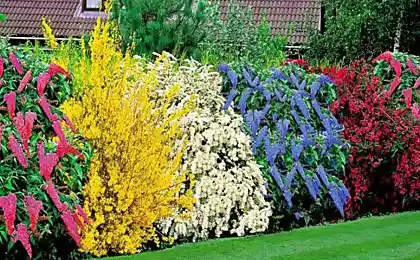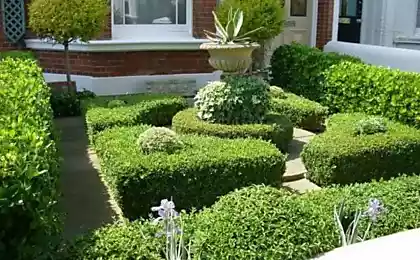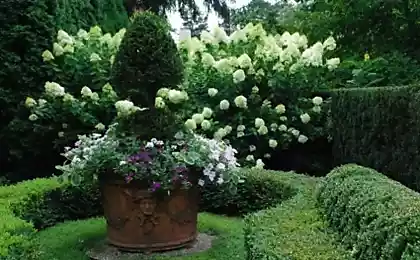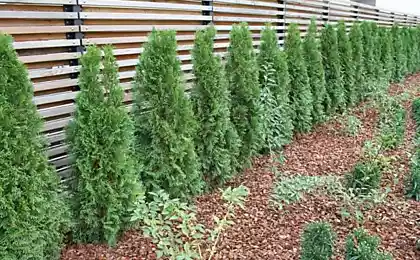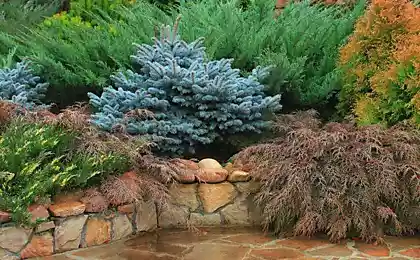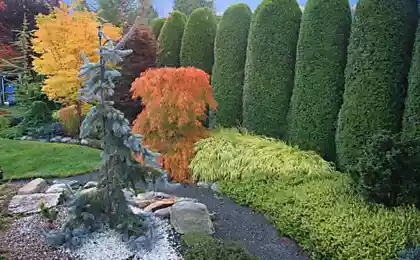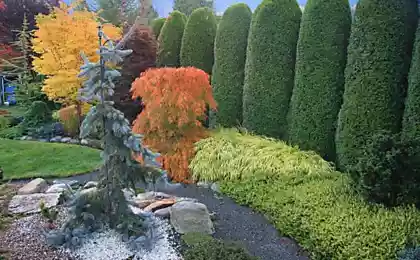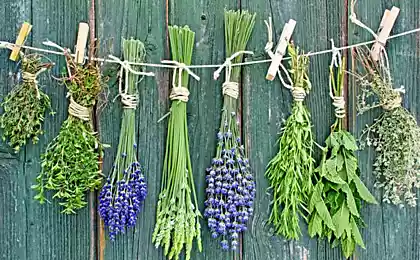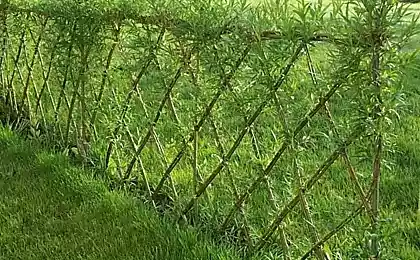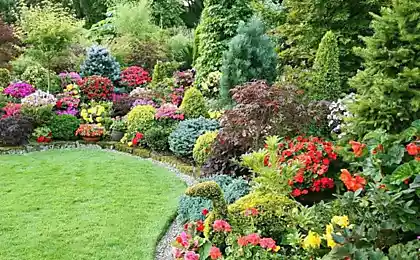750
11 best conifers for hedges

Live conifer hedges look great and very functional: tight and prickly, they protect the site from unwanted eyes and from intruders. However, depending on the stocking density and type of plants can give a fence of the most diverse kind. And they enrich the air with sweet smells and freshness. We choose the best conifers to create a green fence and tell you about their features. Hedges will be divided into molded and free-growing.
Blue spruce (Picea pungens), It tolerates shearing and can form impenetrable, prickly hedges and a wall. The plants should be placed in row 1 through M. These hedges grow slowly, but unlike the Norway spruce, and other conifers tolerate urban conditions (smoke, gas, dust, soot), but also can be damaged by aphids and red spider mites. Is to this kind of eating is the most decorative forms of so-called blue or silver.
Common spruce (Picea excelsa, syn. R. abies)It is also perfectly tolerate a haircut. But dense planting (40 cm), it forms a high and dense living wall that can not be cut. The density of branching and impermeable even for small animals is the best of fences. The crown starts from the ground and shows no sign of thinning, probably because in the first ten years it grows slowly.
For borders you can use decorative shapes:
- ‘Echiniformis’ (dwarf form with a height of 0.2 m, the needles are gray-green, sometimes yellow-green);
- ‘Gregoryana’ (height 0.6-0.8 m, the needles are gray-green)
- Common juniper (Juniperus communis)
The plant density in a single live wall of 0.8-1.0 m. Juniper is valued as a soil-protecting and soil-rock. Grows slowly. Durable. Pests damaged a little, but, as mentioned above, the needles can develop one of ryabchenkov.
The Virginia juniper (Juniperus virginiana)It tolerates shearing and holds an artificial form, and therefore suitable for hedges and walls, formed a shallow cut on the sides (a substantial part of the cones remain on the branches, which enhances the decorative effect of the fence). This species is undemanding to the soil, can grow on dry, infertile, calcareous, hydromorphic soils, make a slight salinity. Stands in urban environments; pests; damaged a little, however, the needles may develop one of ryabchenkov dangerous to pears. Has many decorative forms. The pyramidal form of juniper can substitute for Cupressus sempervirens pyramid in places where it is not growing. Very decorative with a bright-blue waxy coating from small cones in abundance covering the bright green branches.
Cossack juniper (Juniperus sabina)It is perfect for a single wide borders. The plants should be placed with a minimum spacing of 40-50 cm, and the growth of the border conduct regular severe pruning of the protruding branches. The view is especially promising as a conservation breed, on the crumbling slopes, the slopes. Prevents germination of weeds, quickly creates a dense cover thanks to otvodkami and seed reproduction. Drought-tolerant, can grow on stony, sandy and chalky and even saline soils. Pests damaged a little, but needles can develop one of ryabchenkov.
Fun to use and decorative forms of this type, for example, ‘Tamariscifolia’ (Bush height of 1 m, the needles are light bluish green tint).
Thuja occidentalis (Thuja occidentalis)
It is possible to create any shape, molding it perfectly withstands shearing. When creating a hedge it is planted in 40-50 cm; in living walls — through of 0.8-1.0 m. After 7 years, the annual shearing it forms quite dense and very decorative wall, green from the ground. While planting a living wall of columnar form of arborvitae shaping haircut sides is not required. Thuja grows relatively slowly. Undemanding to the soil, it develops better in fertile, loamy, loamy and moist sandy soils by gas resistant, not afraid of the winds. Quite resistant to pests and diseases.
Besides the primary kind of hedges you can use the following decorative forms:
- 'Holmstrup' (conical crown, height up to 4 m);
- 'Smaragd’ (conical form, the growth is moderate);
- 'Fastigiata' (columnar form, replacing the Northern regions, the pyramidal cypress evergreen, conifer in winter, not russets);
- ‘Reingold’ (height 1-2 m, new foliage pink, Golden in summer, bronze in winter);
- ‘Columna’ (narrow columnar form, growth is strong);
- ‘Brabant’ (columnar form, growing quickly);
In the more southern regions of Russia for molded coniferous hedges along with the types listed above, you can apply the yew and cypress Lawson.
Yew (Taxus baccata)from the Renaissance and still the yew is considered the best material for topiary art. It stands up well to any molding and curly hair. Suitable for single-row borders, hedges (low form) or living walls (tall pyramidal shape, almost does not require forming of cutting). Grows very slowly. In the first 3-4 years grows at 1-3 cm Very long-lived (living up to 4 thousand years). Wind-resistant, tolerates dust and gasotherapy. Resistant to pests and diseases, can sometimes damage the root rot. Especially decorative during fruiting from August to November.
Striking forms:
- 'Fastigiata' (columnar form up to 10 m);
- ‘Aurea Fastigiata’ (columnar form up to 6 m with Golden needles);
- Lawson cypress (Chamaecyparis lawsoniana)
Decorative shapes:
- 'Ellwoodii’ (crown conical, conifer young bluish gray);
- 'Alumii' (crown uskollisesta, needles bluish-grey);
- ‘Columnaris’ (columnar form with bluish-green needles; when landing, the placement of plants in a row of 30 cm);
Up to 5 years of age the species grows very slowly and later much faster. Gives abundant root growth. Relatively drought-resistant, undemanding in soil fertility; satisfactorily tolerate urban conditions; fairly resistant to pests and diseases.
The PPE conical spruce (Picea glauca var. albertiana ‘Conica’), It forms a beautiful prickly hedges when planting in a series through 1 m Is a compact dwarf tree height of 2-6 m, with a dense, strictly pyramidal crown. Grows slowly. Light, relatively drought tolerant, prefers well-drained, neutral or slightly acidic soils that are sensitive to smoke and the spring sun. Can be damaged by aphids, red spider mites.
Siberian fir (Abies sibirica)free growing living walls can be made of Siberian fir. It is particularly ornamental in the spring purple color of young cones and brownish-red or yellow-red color male strobile. Prefers fertile, moderately moist soil; sensitive to flue gas and soot. Quite resistant to pests and diseases.
Mountain pine (Pinus mugo), It is recommended only for freely growing hedges and borders, as cut does not increase the branching and the density of the crown. Planting between plants 0.5 m. it Grows slowly. To soil undemanding, drought-resistant, satisfactorily tolerate urban conditions. Resistant to pests and diseases. Especially decorative during flowering, when the crown is studded with large yellow and pink male strobili. published
P. S. And remember, only by changing their consumption — together we change the world! ©
Source: www.7dach.ru
